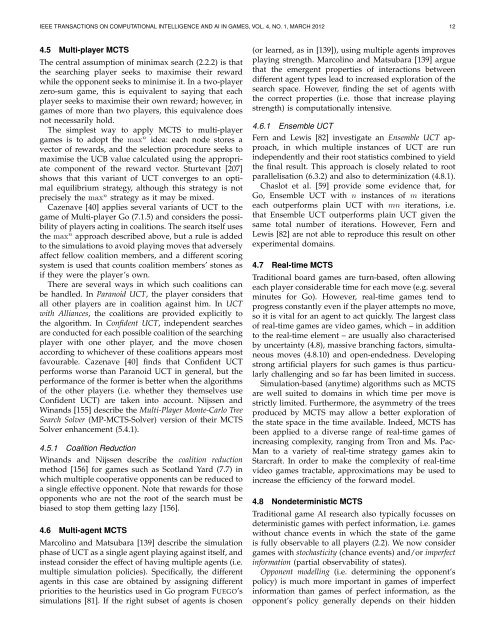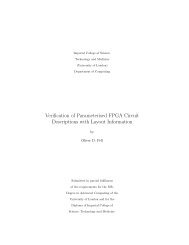A Survey of Monte Carlo Tree Search Methods - Department of ...
A Survey of Monte Carlo Tree Search Methods - Department of ...
A Survey of Monte Carlo Tree Search Methods - Department of ...
You also want an ePaper? Increase the reach of your titles
YUMPU automatically turns print PDFs into web optimized ePapers that Google loves.
IEEE TRANSACTIONS ON COMPUTATIONAL INTELLIGENCE AND AI IN GAMES, VOL. 4, NO. 1, MARCH 2012 12<br />
4.5 Multi-player MCTS<br />
The central assumption <strong>of</strong> minimax search (2.2.2) is that<br />
the searching player seeks to maximise their reward<br />
while the opponent seeks to minimise it. In a two-player<br />
zero-sum game, this is equivalent to saying that each<br />
player seeks to maximise their own reward; however, in<br />
games <strong>of</strong> more than two players, this equivalence does<br />
not necessarily hold.<br />
The simplest way to apply MCTS to multi-player<br />
games is to adopt the max n idea: each node stores a<br />
vector <strong>of</strong> rewards, and the selection procedure seeks to<br />
maximise the UCB value calculated using the appropriate<br />
component <strong>of</strong> the reward vector. Sturtevant [207]<br />
shows that this variant <strong>of</strong> UCT converges to an optimal<br />
equilibrium strategy, although this strategy is not<br />
precisely the max n strategy as it may be mixed.<br />
Cazenave [40] applies several variants <strong>of</strong> UCT to the<br />
game <strong>of</strong> Multi-player Go (7.1.5) and considers the possibility<br />
<strong>of</strong> players acting in coalitions. The search itself uses<br />
the max n approach described above, but a rule is added<br />
to the simulations to avoid playing moves that adversely<br />
affect fellow coalition members, and a different scoring<br />
system is used that counts coalition members’ stones as<br />
if they were the player’s own.<br />
There are several ways in which such coalitions can<br />
be handled. In Paranoid UCT, the player considers that<br />
all other players are in coalition against him. In UCT<br />
with Alliances, the coalitions are provided explicitly to<br />
the algorithm. In Confident UCT, independent searches<br />
are conducted for each possible coalition <strong>of</strong> the searching<br />
player with one other player, and the move chosen<br />
according to whichever <strong>of</strong> these coalitions appears most<br />
favourable. Cazenave [40] finds that Confident UCT<br />
performs worse than Paranoid UCT in general, but the<br />
performance <strong>of</strong> the former is better when the algorithms<br />
<strong>of</strong> the other players (i.e. whether they themselves use<br />
Confident UCT) are taken into account. Nijssen and<br />
Winands [155] describe the Multi-Player <strong>Monte</strong>-<strong>Carlo</strong> <strong>Tree</strong><br />
<strong>Search</strong> Solver (MP-MCTS-Solver) version <strong>of</strong> their MCTS<br />
Solver enhancement (5.4.1).<br />
4.5.1 Coalition Reduction<br />
Winands and Nijssen describe the coalition reduction<br />
method [156] for games such as Scotland Yard (7.7) in<br />
which multiple cooperative opponents can be reduced to<br />
a single effective opponent. Note that rewards for those<br />
opponents who are not the root <strong>of</strong> the search must be<br />
biased to stop them getting lazy [156].<br />
4.6 Multi-agent MCTS<br />
Marcolino and Matsubara [139] describe the simulation<br />
phase <strong>of</strong> UCT as a single agent playing against itself, and<br />
instead consider the effect <strong>of</strong> having multiple agents (i.e.<br />
multiple simulation policies). Specifically, the different<br />
agents in this case are obtained by assigning different<br />
priorities to the heuristics used in Go program FUEGO’s<br />
simulations [81]. If the right subset <strong>of</strong> agents is chosen<br />
(or learned, as in [139]), using multiple agents improves<br />
playing strength. Marcolino and Matsubara [139] argue<br />
that the emergent properties <strong>of</strong> interactions between<br />
different agent types lead to increased exploration <strong>of</strong> the<br />
search space. However, finding the set <strong>of</strong> agents with<br />
the correct properties (i.e. those that increase playing<br />
strength) is computationally intensive.<br />
4.6.1 Ensemble UCT<br />
Fern and Lewis [82] investigate an Ensemble UCT approach,<br />
in which multiple instances <strong>of</strong> UCT are run<br />
independently and their root statistics combined to yield<br />
the final result. This approach is closely related to root<br />
parallelisation (6.3.2) and also to determinization (4.8.1).<br />
Chaslot et al. [59] provide some evidence that, for<br />
Go, Ensemble UCT with n instances <strong>of</strong> m iterations<br />
each outperforms plain UCT with mn iterations, i.e.<br />
that Ensemble UCT outperforms plain UCT given the<br />
same total number <strong>of</strong> iterations. However, Fern and<br />
Lewis [82] are not able to reproduce this result on other<br />
experimental domains.<br />
4.7 Real-time MCTS<br />
Traditional board games are turn-based, <strong>of</strong>ten allowing<br />
each player considerable time for each move (e.g. several<br />
minutes for Go). However, real-time games tend to<br />
progress constantly even if the player attempts no move,<br />
so it is vital for an agent to act quickly. The largest class<br />
<strong>of</strong> real-time games are video games, which – in addition<br />
to the real-time element – are usually also characterised<br />
by uncertainty (4.8), massive branching factors, simultaneous<br />
moves (4.8.10) and open-endedness. Developing<br />
strong artificial players for such games is thus particularly<br />
challenging and so far has been limited in success.<br />
Simulation-based (anytime) algorithms such as MCTS<br />
are well suited to domains in which time per move is<br />
strictly limited. Furthermore, the asymmetry <strong>of</strong> the trees<br />
produced by MCTS may allow a better exploration <strong>of</strong><br />
the state space in the time available. Indeed, MCTS has<br />
been applied to a diverse range <strong>of</strong> real-time games <strong>of</strong><br />
increasing complexity, ranging from Tron and Ms. Pac-<br />
Man to a variety <strong>of</strong> real-time strategy games akin to<br />
Starcraft. In order to make the complexity <strong>of</strong> real-time<br />
video games tractable, approximations may be used to<br />
increase the efficiency <strong>of</strong> the forward model.<br />
4.8 Nondeterministic MCTS<br />
Traditional game AI research also typically focusses on<br />
deterministic games with perfect information, i.e. games<br />
without chance events in which the state <strong>of</strong> the game<br />
is fully observable to all players (2.2). We now consider<br />
games with stochasticity (chance events) and/or imperfect<br />
information (partial observability <strong>of</strong> states).<br />
Opponent modelling (i.e. determining the opponent’s<br />
policy) is much more important in games <strong>of</strong> imperfect<br />
information than games <strong>of</strong> perfect information, as the<br />
opponent’s policy generally depends on their hidden















